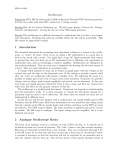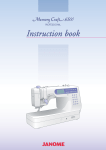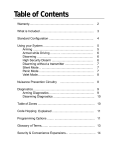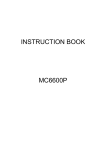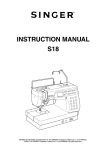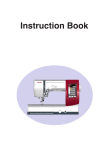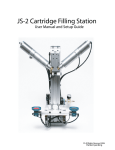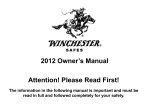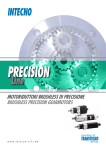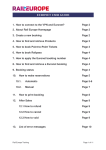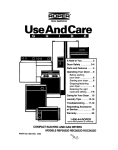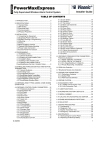Download JANOME Memory Craft 6300 Professional Instruction Booklet
Transcript
INSTRUCTION BOOK IMPORTANT SAFETY INSTRUCTIONS This appliance is not intended for use by persons (including children) with reduced physical, sensory or mental capabilities, or lack of experience and knowledge, unless they have been given supervision or instruction concerning use of the appliance by a person responsible for their safety. Children should be supervised to ensure that they do not play with this sewing machine. When using an electrical appliance, basic safety precautions should always be followed, including the following: This sewing machine is designed and manufactured for household use only. Read all instructions before using this sewing machine. DANGER— To reduce the risk of electric shock: 1. An appliance should never be left unattended when plugged in. Always unplug this sewing machine from the electric outlet immediately after using and before cleaning. 2. Always unplug before replacing a sewing machine bulb. Replace bulb with same type rated 12 Volts, 5 Watts. WARNING— To reduce the risk of burns, fire, electric shock, or injury to persons: 1. Do not allow to be used as a toy. Close attention is necessary when this sewing machine is used by or near children. 2. Use this appliance only for its intended use as described in this ownerʼs manual. Use only attachments recommended by the manufacturer as contained in this ownerʼs manual. 3. Never operate this sewing machine if it has a damaged cord or plug, if it is not working properly, if it has been dropped or damaged, or dropped into water. Return this sewing machine to the nearest authorized dealer or service center for examination, repair, electrical or mechanical adjustment. 4. Never operate the appliance with any air opening blocked. Keep ventilation openings of this sewing machine and foot controller free from accumulation of lint, dust and loose cloth. 5. Never drop or insert any object into any opening. 6. Do not use outdoors. 7. Do not operate where aerosol (spray) products are being used or where oxygen is being administered. 8. To disconnect, turn all controls to the off (“O”) position, then remove plug from outlet. 9. Do not unplug by pulling on cord. To unplug, grasp the plug, not the cord. 10. Keep fingers away from all moving parts. Special care is required around the sewing machine needle and/or cutting blade. 11. Always use the proper needle plate. The wrong plate can cause the needle to break. 12. Do not use bent needles. 13. Do not pull or push fabric while stitching. It may deflect the needle causing it to break. 14. Switch this sewing machine off (“O”) when making any adjustment in the needle area, such as threading the needle, changing the needle, threading the bobbin or changing the presser foot, and the like. 15. Always unplug this sewing machine from the electrical outlet when removing covers, lubricating, or when making any other adjustments mentioned in this ownerʼs manual. The design and specifications are subject to change without a prior notice. SAVE THESE INSTRUCTIONS Please note that on disposal, this product must be safely recycled in accordance with relevant National legislation relating to electrical/electronic products. If in doubt please contact your retailer for guidance. (European Union only) OPERATING INSTRUCTION: For appliances with a polarized plug (one blade wider than the other): To reduce the risk of electric shock, this plug is intended to fit in a polarized outlet only one way. If the plug does not fit fully in the outlet, reverse the plug. If it still does not fit, contact a qualified electrician to install the proper outlet. Do not modify the plug in any way. Foot Controller 21371 for use with this sewing machine. Do’s and Don’ts 1. Always be aware of the up-and-down movement of the needle and do not turn your attention away from the machine while it is running. 2. When leaving the sewing machine unattended, the main switch of the machine must be switched off or the plug must be removed from the socket-outlet. 3. When servicing the sewing machine, or when removing covers or changing lamps, the machine must be disconnected from the power supply by removing the plug from the socket-outlet. 4. Do not place anything on the foot control, otherwise the machine will start inadvertently, or the control or motor may burn out. 5. The maximum permissible power for the sewing lamp bulb is 5 watts. 6. When using your sewing machine for the first time, place a piece of waste fabric under the presser foot and run the machine without thread for a few minutes. Wipe away any oil which may have appeared. KNOW YOUR MACHINE Names of Parts ................................................................. 2 Attaching the quick referencce board ................................ 2 Standard Accessories ....................................................... 3 UTILITY STITCHES Buttonholes ..................................................................... 34 Variety of buttonholes ................................................ 34 Sensor buttonholes .................................................... 34 Double layer buttonhole ............................................. 37 Corded buttonhole ..................................................... 37 Changing buttonhole width ........................................ 38 Changing buttonhole stitch density ............................ 38 Automatic buttonhole ................................................. 39 Button Sewing ................................................................. 41 Darning ............................................................................ 42 To sew a shorter darning ............................................ 43 To sew the same size darning .................................... 43 To adjust the eveness of darning ............................... 43 Tacking ............................................................................ 44 To sew a shorter tack ................................................. 44 To sew the same size tack ......................................... 44 Eyelet .............................................................................. 45 Adjusting the shape of an eyelet ................................ 45 GETTING READY TO SEW Connecting the Power Supply ........................................... 4 Controlling Sewing Speed ................................................. 4 Speed control lever ...................................................... 4 Foot control .................................................................. 4 Function Buttons ............................................................... 5 Raising and Lowering the Presser Foot ............................ 7 Attaching the Knee Lifter ................................................... 7 Variety of Presser Feet and Their Uses ............................ 8 Changing the Presser Foot ............................................... 9 Detaching and Attaching the Foot Holder ......................... 9 Attaching the even feed foot ........................................... 10 Attaching the darning foot P ............................................ 10 Winding the Bobbin ......................................................... 11 Removing the bobbin ................................................. 11 Setting the spool of thread ......................................... 11 Winding the bobbin .................................................... 12 Inserting the bobbin ................................................... 13 Threading the Machine ................................................... 14 Automatic Needle Threader ............................................ 16 Drawing Up the Bobbin Thread ....................................... 17 Changing Needles........................................................... 18 Fabric and Needle Chart ................................................. 18 Balancing Thread Tension ............................................... 19 Adjusting the Foot Pressure ............................................ 20 Dropping the Feed Dog ................................................... 20 PATCHWORK AND QUILTING Patchwork ....................................................................... 46 Patchwork stitches ..................................................... 46 Quilting bar for the zigzag foot ................................... 47 Freemotion quilting .................................................... 47 Clasp stitch ................................................................ 48 PATTERN PROGRAMMING AND DECORATIVE STITCHES Programming a Pattern Combination .............................. 49 Sewing the pattern combiantion from the beginning ..... 49 Pattern combination with auto thread cutting ............. 50 Elongation Sewing .......................................................... 51 Fagoting .......................................................................... 52 Smocking ........................................................................ 52 Applique .......................................................................... 53 Twin Needle Sewing ........................................................ 54 Correcting Distorted Patterns .......................................... 56 Reviewing the Programmed Pattern Combination .......... 57 Deleting a Pattern from the Programmed Combination .. 57 Inserting a Pattern in the Programmed Combination ...... 58 Duplicating a Pattern in the Programmed Combination .. 58 Uniform Stitch Adjustment of the Programmed Patterns . 59 Uniform stitch adjustment after sewing the pattern combination ................................................................ 59 Individual Stitch Adjustment of the Progarmmed Pattens ... 60 BASIC STITCHES Straight Stitch .................................................................. 21 To sew from the edge of thick fabric .......................... 21 Securing seam ........................................................... 21 Changing sewing direction ......................................... 22 Using the cloth guide ................................................. 22 Using the seam guide lines ........................................ 22 Adjusting the needle drop position ............................. 23 Adjusting the stitch length .......................................... 23 Variety of the straight stitches .................................... 24 Basting ............................................................................ 25 Zigzag Stitch ................................................................... 26 Adjusting the stitch width ........................................... 26 Adjusting the stitch length .......................................... 26 Variety of Overcasting Stitches ....................................... 27 Zipper Sewing ................................................................. 29 Rolled Hem ..................................................................... 32 Shell Tucking ................................................................... 32 Blind Hem ........................................................................ 33 CARE OF THE MACHINE Cleaning the Hook Race and Feed Dog ......................... 61 Assembling the hook race .......................................... 61 Replacing the Light Bulb ................................................. 62 Problems and Warning Signals ....................................... 63 Troubleshooting .............................................................. 65 1 5 3 2 6 KNOW YOUR MACHINE 7 Name of Parts 4 8 1 9 10 11 27 12 26 13 25 14 24 23 22 17 16 15 18 32 30 31 19 28 29 20 21 33 41 40 1. 2. 3. 4. 5. 6. 7. 8. 9. 10. 11. 12. 13. 14. 15. 16. 17. 18. 19. 20. 21. 22. 23. 24. 25. 26. 27. 28. 29. 30. 31. 32. 33. 34. 35. 36. 37. 38. 39. 40. 41. Foot Pressure Dial Thread Take-up Lever Thread Guide Quick Reference Board Speed Control Lever Retractable Thread Guide Bobbin Winder Spindle Bobbin Winder Stopper LED Window Function Buttons Stitch Width Adjusting Button Stitch Length Adjusting Button Pattern Seleection Button Drop Feed Lever Knee Lifter Socket Stitch Balance Adjusting Dial Tension Regulating Dial Thread Cutter Button Up/Down Needle Button Auto-Lock Button Reverse Button Hook Cover Plate Release Button Hook Cover Plate Needle Plate Needle Threader Thread Cutter Face Plate Zigzag Foot A Thumb Screw Foot Holder Needle Needle Clamp Screw Carrying Handle Presser Foot Lifter Buttonhole Lever Spool Pins Machine Sockets Power Switch Handwheel Thread Guide Bobbin Winding Tension Disk 2 34 39 35 38 1 Attaching the quick reference board 36 37 2 The quick reference board and setscrews are included in the standard accessories. Fix the quick reference board on the backside of the machine with the two setscrews. Tighten the screws firmly with a screwdriver. 1 Setscrews 2 Quick Reference Board Standard Accessories 1 2 3 5 4 6 9 8 7 11 10 1. 2. 3. 4. 12 14 13 5. 6. 7. 8. 9. 10. Satin Stitch Foot F Blind Hem Foot G Cording Foot H Overcasting Foot M Automatic Buttonhole Foot R Screwdriver 11. 12. 13. 14. 15. 16. Screwdriver Set of Needles Lint Brush Seam Ripper Spool Holder (Large) Spool Holder (Small) 17. 18. 19. 20. Bobbins Quilting Bar Quilting Bar for Even Feed Foot Basting/Darning Foot P 21. 1/4” Seam Foot O 22. Even Feed Foot 23. Open Toe Satin Stitch Foot F-2 16 15 Zigzag Foot A (comes attached to the machine) Overedge Foot C Rolled Hem Foot D Zipper Foot E 17 24. Cloth Guide with Screw 25. Instruction Book 26. Power Supply Cord 27. Foot Control 28. Accessory Box 19 18 29. Foot Storage Compartment (marked with letters corresponding to the presser feet.) 30. Knee Lifter 20 23 22 21 24 30 28 29 27 25 26 3 GETTING READY TO SEW Connecting the Power Supply 1 Turn off the power switch. Insert the foot control plug into the machine socket. Insert the machine plug into the machine socket. Insert the power supply plug into the wall outlet. Turn on the power switch. 1 Power Switch 2 Foot Control Plug 3 Machine Socket 4 Machine Plug 5 Power Supply Plug 6 Wall Outlet 3 4 3 6 2 NOTE: If you turn off the power switch, wait for 5 seconds before turning it on again. 5 For Your Safety: While in operation, always keep your eyes on the sewing area, and do not touch any moving parts such as the thread take-up lever, handwheel or needle. Always turn off the power switch and unplug from the power supply: - when leaving the machine unattended. - when attaching or removing parts. - when cleaning the machine. Do not place anything on the foot control, otherwise the machine will run inadvertently. Operating Instructions: The symbol “O” of a switch indicates the “off” position of a switch. Controlling Sewing Speed Speed control lever You can limit the maximum sewing speed by the speed control lever according to your sewing needs. To increase sewing speed, slide the lever to the right. To decrease sewing speed, slide the lever to the left. Foot control Pressing on the foot control can vary sewing speed. The harder you press the foot control, the faster the machine runs. NOTES: The machine runs at the maximum speed set by the speed control lever when the foot control is being fully depressed. Keep the foot control free from accumulation of lint, dust and loose cloth. Do not place anything on the foot control. 4 Function Buttons 1 Thread cutter button 1 Press this button after finishing sewing and the machine will trim the threads. The LED signal blinks while cutting the threads. 5 Thread Cutter Signal 5 2 6 3 NOTES: The auto thread cutter does not work if the presser foot is raised. The auto thread cutter will work well with normal sewing threads #30 or finer. Use the thread cutter on the face plate to cut the specialized or thick threads if the auto thread cutter does not work well. When starting the next seam, pull the needle thread to pick 4 the bobbin thread up and draw them to the back and under the foot. Clean the auto thread cutter mechanism regularly to avoid malfunction due to built up lint. Avoid using a paper spool when it begins to empty since it will not unwind smoothly. It may cause the thread to bunch or slip when using the auto thread cutter. 2 Up/Down needle button Press this button to bring the needle bar up or down. The LED signal will turn on when the needle is down. The LED signal will turn off when the needle is up. The machine will stop with the needle up or down depending on the needle position determined by this button. The machine will always stop with the needle up after auto thread cutting or buttonhole stitching. 6 LED signal 3 Auto-Lock button When stitch pattern 01, 02 or 07 has been selected, the machine will immediately sew locking stitches and automatically stop when the auto-lock button is pressed. When sewing all other stitches, the machine will sew locking stitches at the end of the pattern being sewn and automatically stop. 4 Reverse button When stitch pattern 01, 02 or 07 has been selected, the machine will sew in reverse while the reverse button is pressed. If you press the reverse button when sewing all other stitches, the machine will immediately sew locking stitches and automatically stop. 5 Function Buttons 1 5 2 6 Stitch width adjusting button: Press this button to alter the stitch 4 3 width. 6 7 7 Stitch length adjusting button: Press this button to alter the stitch length. 8 8 Pattern selection buttons Press one of these buttons until a pattern number of the desired pattern is displayed in the LED 1 Bobbin winding button: Press this button to wind the bobbin. window. 2 Twin needle button: Press this button when sewing with a twin needle. 3 Clear button Press this btton to delete the last pattern programmed. Holding this button being pressed will delete the entire program. 4 Memory button: Press this button to memorize programmed pattern combinations. The previous pattern combination will be replaced by the new combination when pressing this button after programming. 5 Elongation button: Press this button to elongate satin stitch patterns. 6 Raising and Lowering the Presser Foot The presser foot lifter raises and lowers the presser foot. You can raise the presser foot about 6 mm (1/4") higher than the normal up position by exerting more pressure when lifting the presser foot lifter. This allows for easy removal of the presser foot and helps you to place thick fabrics under it. 1 1 Presser Foot Lifter 2 Presser Foot 3 Up Position 2 4 Extra Lift NOTE: If you start the machine with the presser foot up, the LED window will advise you to lower the foot. Lower the foot then restart the machine. 4 3 Attaching the Knee Lifter The Knee Lifter is extremely helpful when sewing applique, patchwork and quilting since it allows you to 3 handle the fabric while your knee controls the presser 2 foot. Match the ribs on the knee lifter with the notches in the knee lifter socket and insert the knee lifter. 1 Knee Lifter 2 Ribs 3 Notches Push the knee lifter with your knee to raise and lower the presser foot. 1 NOTE: Do not touch the knee lifter while sewing, otherwise the fabric will not be fed smoothly. 7 Variety of Presser Feet and Their Uses 1 1 Zigzag foot A: This is the most versatile foot. It can be used for various stitches including straight stitches and zigzag stitches. It is designed to achieve firm and neat seam results. 2 2 Overedge foot C: This foot is exclusively for overedging. The brush on the foot effectively prevents skipped stitches on the raw edge of fabrics. 3 3 Rolled hem foot D: This special foot is for sewing a rolled hem. The curl of the foot helps to form a hem at a constant width. 4 4 Zipper foot E: This foot is for sewing zippers. The zipper teeth are guided through the grooves on the bottom of the foot. 5 5 Satin stitch foot F: This clear plastic foot is ideal for satin stitches and decorative stitches. The center groove on the bottom of the foot ensures smooth feeding of dense stitches. 6 6 Craft foot F-2: This is an open toe satin stitch foot for patchwork and appliqué. 7 7 Blind hem foot G: This foot is specially designed for blind hemming. The guide on the foot helps feed the fabric and sew a straight and nearly invisible blind-hem. 8 8 Cording foot: This foot is specially designed to hold one or three strands of cording to create braiding. 9 10 10 1/4” seam foot O: This foot is useful for patchwork piecing. The guide on the foot maintains an exact 1/4” (0.7 cm) seam allowance. 11 12 13 9 Overcasting Foot M: This foot is specially designed to simulate professional style overlocking. The wires on the foot effectively prevent the fabric edge from puckering or rolling. 11 Basting/darning foot P: This is a special foot for basting. It holds the fabric while taking a stitch, synchronizing with the needle bar movement. This foot can also be used for freemotion embroidery or quilting. 12 Automatic buttonhole foot R: This foot is for buttonholes and for darning. Place a button in the button holder on the rear of the foot. This automatically sets the buttonhole size. 13 Even feed foot: This is a special attachment for hard-to-feed materials. This foot effectively prevents fabrics from shifting and puckering. It is great for quilting and matching plaids. 8 Changing the Presser Foot CAUTION: 2 3 Turn OFF the power switch before changing the foot. Always use the proper foot for the selected pattern. Wrong foot can cause the needle to break. To snap off: Raise the needle and presser foot. Press the red button on the back of the foot holder and the foot will drop. 1 Red Button 2 Foot Holder 3 Presser Foot 1 5 4 To snap on: Place the presser foot so the pin on the foot lies just under the groove of the foot holder. Lower the foot holder to lock the foot in place. Each foot is marked with a letter for identification. 4 Groove 5 Pin 6 Identification Letter 6 Detaching and Attaching the Foot Holder WARNING: 2 Turn OFF the power switch before detaching or attaching the foot holder. To detach: Raise the presser bar and turn the thumbscrew counterclockwise to remove the foot holder. 1 Thumbscrew 2 Foot holder 1 3 2 To attach: Align the hole in the foot holder with the threaded hole in the presser bar and insert the thumbscrew through the hole. Tighten the thumbscrew by turning it clockwise. 3 Presser Bar 1 9 Attaching the even feed foot 2 Remove the foot holder. Attach the even feed foot to the presser bar with the lever over the needle clamp screw and secure it with the thumb screw. 1 Thumb screw 2 Lever 3 Presser Bar 3 1 2 Attaching the darning foot P 3 1 Loosen the thumbscrew and remove the foot holder. Attach the darning foot P to the presser bar putting the pin on the needle clamp screw. Tighten the thumbscrew firmly with the screwdriver. 1 2 3 10 Thumbscrew Pin Needle Clamp Screw Winding the Bobbin Removing the bobbin Slide the hook cover plate release button to the right, 1 and remove the hook cover plate. Lift out the bobbin from the bobbin holder. 1 Hook Cover Plate Release Button 2 Hook Cover Plate 3 Bobbin NOTES: 2 Avoid using a bobbin when it begins to empty since it may cause thread bunching. Always use the correct bobbin. Using a wrong bobbin may cause malfunctions. 3 Setting the spool of thread Place the spool of thread on the spool pin with the thread coming off the spool as shown. Attach the spool holder, and press it firmly against the spool of thread. 3 1 1 Spool of Thread 2 Spool Pin 3 Spool Holder NOTES: Avoid using a paper spool when it begins to empty since it will not unwind smoothly. It may cause the thread to bunch or slip when using the auto thread cutter. 2 5 5 4 Use the large spool holder for ordinary spools, while the small spool holder for small spools. 4 Small Spool 5 Small Spool Holder 4 11 z Winding the bobbin 1 z Pass the thread through the guide on the thread guide post from behind. 1 Thread Guide Post 2 x Pass the thread under the bobbin winding tension disk. 2 Bobbin Winding Tension Disk x c c Thread through the hole in the bobbin from the inside to the outside. Put the bobbin on the bobbin winder spindle. 3 Bobbin Winder Spindle 3 v Push the bobbin winder stopper to the left. v 4 Hold the free end of the thread in your hand 5 and press the bobbin winding button. Press the bobbin winding button again to stop the bobbin when it has made several turns, and cut the thread close to the hole in the bobbin. 4 Bobbin Winder Stopper 5 Bobbin Winding Button b b Press the bobbin winding button again. When the bobbin is fully wound, the machine will stop automatically. n Return the bobbin winder stopper to its original n position, and cut the thread. NOTE: This machine has an exclusive motor for bobbin winding, which allows you to wind the bobbin while stitching. 12 Inserting the bobbin z z Place the bobbin in the bobbin holder with the thread running off counterclockwise. 1 Thread 1 2 Bobbin Holder 2 x Guide the thread into notch (A) on the front of the bobbin holder. x (A) c c Draw the thread to the left, sliding it between the tension spring blades. v Continue to draw the thread lightly until the thread v slips into side notch (B). The bobbin should turn counterclockwise when pulling the bobbin thread. If not, reverse the bobbin and re-thread. (B) b b Pull out about 10 cm (4") of thread to the rear. 3 Refer to the threading chart shown on the hook cover plate. Reattach the hook cover plate. 3 Threading Chart 13 v Threading the Machine z 1 Raise the presser foot lifter. Press the up/down c needle button twice to raise the needle to its highest 2 position. x z Pass the thread through the guide on the thread guide bar from behind. 1 Thread Guide Bar x Pass the thread through the right thread guide. 2 Right Thread Guide n b m , c Hold the upper thread with both hands as shown c and slip it under the thread guide plate. 3 Thread Guide Plate 3 v Draw the thread toward you and pass it into v the left thread guide. Draw the thread along the right channel. 4 Left Thread Guide 4 14 Threading the Machine (continued) b Draw the thread down and around the tension b dial from the right to the left. While holdin the thread beside the left thread guide, pull the thread up to insert it between the tension disks and under the loop of the check spring. Be sure that the thread is coming out from notch of the disk. 5 Check Spring 6 Notch 6 5 n Firmly draw the thread up to the take-up lever n and down into its eye from the right to the left, while holding the thread beside the left thread guide. 7 Eye of the Thread Take-up Lever 7 m Draw the thread down through the lower thread guide from the right. 8 8 Lower Thread Guide m , Slip the thread behind the needle bar thread guide on the left. , 9 Needle Bar Thread Guide 9 . Thread the needle from front to back by hand or use the automatic needle threader. . 15 Automatic Needle Threader Raise the needle to its highest position by pressing the up/down needle button twice. Turn the power switch off. Lower the presser foot. z z Depress the needle threader knob as far as it will go. The hook comes out through the needle eye from behind. 1 Needle Threader Knob 2 Hook 1 2 x Draw the thread down around the threader guide and x under the hook. 3 Threader Guide 2 3 c Release the threader knob slowly while holding the c thread end with your hand. A loop of the thread is pulled up through the needle eye. 4 v 4 Loop of Thread v Remove the loop from the threader and pull out the thread end from the needle eye. NOTES: The automatic threader works well with the threads #50-90 and needles #11-16, including the blue tipped needle. The automatic needle threader cannot be used for threading the twin needle. If the hook fails to pull a loop of the thread, check the needle and its setting. 16 Drawing Up the Bobbin Thread z z Raise the Presser Foot Lifter. Hold the needle thread with your finger and press the up/down needle button twice to pick up the bobbin 2 thread. 1 Needle Thread 2 Needle Up/Down Button 1 x Draw up the needle thread to bring up a loop of the bobbin thread. x 3 Bobbin Thread 1 3 c c Slide 10 cm (4") of both threads to the back under the presser foot. 17 Changing Needles z Raise the needle by pressing the up/down needle button and lower the presser foot. Turn off the power switch. 1 z Loosen the needle clamp screw by turning it counterclockwise. Remove the needle from the clamp. 1 Needle Clamp Screw 2 x 2 x Insert a new needle into the needle clamp with the flat side of the needle to the rear. When inserting the needle into the needle clamp, push it up against the stopper pin and tighten the needle clamp screw firmly. 2 Stopper Pin 3 Flat Side 3 To check needle straightness, place the flat side of the needle onto something flat (a needle plate, glass etc.) The gap between the needle and the flat surface should be consistent. Never use a blunt needle. 4 Gap 4 CAUTION: Always make sure to turn the power switch off and disconnect the machine from power supply before changing the needle. Fabric and Needle Chart WEIGHT FABRIC TYPE of NEEDLE NEEDLE SIZE Very Light Chiffon, Georgette, Fine Lace, Organdy Net, Tulle Universal Ball Point 9 (65) 9 (65) Light Batiste, Voile, Lawn, Pure Silk, Crepe de Chine, Sheer Crepe, Chambray, Handkerchief Linen, Gingham, Challis, Percale, Wool Crepe, Peau de Soie, Taffeta, Satin, Silk Surah, Satin-backed Crepe, Qiana Blue Tipped Needle Universal 11 (75) 11 (75) 12 (80) Single Knits, Jersey, Swim wear, and Tricot Blue Tipped Needle Ball Point 11 (75) 11 (75) Leather Suede Wedge Point Leather Needle 11 (75) Flannel, Velour, Velvet, Muslin, Velveteen, Poplin, Corduroy, Broadcloth, Linen, Chintz, Gabardine, Felt, Terry, Burlap, Quilted Fabrics Universal 14 (90) Double Knits, (synthetic and natural) Stretch Velour, Stretch Terry, Sweater Knits Ball Point 14 (90) Leather, Vinyl, Suede Wedge Point Leather Needle 14 (90) Denim, Sailcloth, Ticking Denim Needle 16 (100) Double Faced Wool, Heavy Coating, Fake Fur, Drapery Fabrics Universal 16 (100) Leather, Suede Wedge Point Leather Needle 16 (100) 18 (110) Canvas, Duck, Upholstery Fabrics Universal 16 (100) Topstitching Needle 14 (90) Medium Heavy Very Heavy Topstitching for Special Finish 18 Balancing Thread Tension Correct tension: The ideal straight stitch has threads locked between 3 1 2 two layers of fabric. For an ideal zigzag stitch, the bobbin thread does not show on the right side of the fabric, and the needle thread shows slightly on the wrong side of the fabric. 1 Needle Thread 2 Right Side of the Fabric 4 3 Wrong Side of the Fabric 4 Bobbin Thread 5 Adjusting the tension Tension adjustment may be needed depending on the sewing materials, layers of fabric and other sewing 5 4 3 Turn the tension control dial to set the desired number 7 6 2 1 at the setting mark. 5 Setting Mark 0 9 8 2 conditions. 6 6 Tension Control Dial 3 1 Needle thread tension is too tight: The bobbin thread will appear on the right side of the fabric. Loosen the needle thread tension by moving the dial to a lower number. 4 2 3 1 Needle thread tension is too loose: The needle thread will appear on the wrong side of the fabric. Tighten the needle thread tension by moving the dial to a higher number. 4 19 Adjusting the Foot Pressure The foot pressure dial should be set at “3” for regular sewing. 1 Reduce the pressure for appliqué, sewing on fine synthetics and elastic fabrics. Set the dial at “1” when sewing extra fine fabrics. 1 Foot Pressure Dial 2 Setting mark 2 0 1 2 3 NOTE: Do not reduce the foot pressure lower than “0”. Dropping the Feed Dog The feed dog can be lowered by the drop feed lever for sewing on buttons, freemotion embroidery etc. 1 Shift the drop feed lever to the right to lower the feed dog. Shift the lever to the left to raise the feed dog, it will return to the up position when starting the machine. 1 Drop Feed Lever NOTE: The feed dog should be in up position for normal sewing. A message will show on the LED window when starting the machine with the feed dog dropped. The machine will run with the feed dog dropped when pattern 01, 02, 07, 31 or 62 has been selected. The machine will not sew with the feed dog dropped when other patterns have been selected. 20 BASIC STITCHES Straight Stitch Machine Setting Pattern: 01 or 02 Thread tension:2-6 Presser foot: Zigzag foot A Foot pressure: 3 To sew Raise the presser foot and position the fabric next to a seam guide line on the needle plate. Lower the needle to the point where you wish to start. Pull the needle and bobbin threads toward the rear. Lower the presser foot. Depress the foot control to start sewing. Gently guide the fabric along the seam guide line letting the fabric feed naturally. 2 1 3 4 To sew from the edge of thick fabric The black button on the zigzag foot locks the foot in the horizontal position. This is helpful when starting sewing from extreme edge of thick fabrics or sewing across a hem. Lower the needle into the fabric at the point where you wish to start sewing. Lower the foot while pushing the black button in. The foot is locked in the horizontal position to avoid slipping. 1 Thick Fabrics 2 Black Button Securing seam For fastening the ends of seams, press the reverse button and sew several reverse stitches. The machine sews in reverse as long as you press and hold the reverse button. Press the reverse button once when sewing the Lock-aMatic stitch (pattern 03) or locking stitch (pattern 04) so the machine will lock the stitch off and stop automatically. After finishing sewing, press the thread cutter button to cut the threads. 3 Thread Cutter Button NOTE: Use the thread cutter on the face plate to cut the specialized or thick threads if the auto thread cutter does not work well. 4 Thread Cutter 21 Changing sewing direction: Stop the machine a few stitches before the end of a seam. Press the up/down needle button a few times until the needle falls on the end of the seam. Raise the presser foot. Pivot the fabric around the needle to change the sewing direction as desired. Lower the presser foot and start sewing in a new direction. 1 Using the cloth guide: 2 Attach the cloth guide on the needle plate with a screw. Adjust the position of the cloth guide and tighten the 3 screw. Place the fabric with its edge against the cloth guide and sew. 1 Screw 2 Cloth Guide 3 Threaded Hole Using the seam guide lines: 1 The seam guides on the needle plate and hook cover help 2 you to measure seam allowance. 1 Center Needle Position 2 Edge of the Fabric 3 Guide Lines NOTE: 3 The numbers on the needle plate indicate the distance from the center needle position in millimeters and inches. 22 Adjusting the needle drop position The needle drop position can be altered by pressing the stitch width adjusting button. Press the right side of the button (+ sign) to move the needle bar to the right. Press the left side of the button (- sign) to move the needle bar to the left. 3.5 0.0 7.0 Adjusting the stitch length The stitch length can be altered by pressing the stitch length adjusting button. Press the right side of the button (+ sign) to increase the stitch length. Press the left side of the button (- sign) to decrease the 1.0 5.0 stitch length. 23 Variety of the straight stitches 02 Straight stitch with left needle position Use this stitch to seam the edge of fabrics. 03 Lock-a-Matic stitch Use this stitch to secure the beginning and the end of a seam with backstitching. When you reach the end of the seam, press the reverse button once. The machine will sew four reverse stitches, four forward stitches, and then stop sewing automatically. 04 Triple stretch stitch This strong, durable stitch is recommended for areas where both elasticity and strength are needed to ensure comfort and durability. Use it to reinforce areas such as crotch and armhole seams. Also use it when constructing items such as backpacks for extra strength. 05 Stretch stitch This is a narrow stretch stitch designed to eliminate puckering on knit fabrics and bias seams, while permitting the seam to be pressed completely open flat. 24 Basting Machine Setting Pattern: 06 Thread tension:1-3 Presser foot: Darning foot P Foot pressure: 1 Feed dog: Dropped The basting stitch is used to hold fabric layers together during fitting. Lower the feed dog and set the foot pressure dial at “1”. Draw the both needle and bobbin threads to the back. Depress the foot control. The machine will take one stitch and stop automatically. Release the foot control. Hold the fabric taut and slide it to a place where you want the next stitch. CAUTION: Do not pull the fabric while stitching. It may deflect the needle causing it to break. 25 Zigzag Stitch Machine Setting Pattern: 07 Thread tension: 3-7 Presser foot: Zigzag foot A Foot pressure: 3 Zigzag stitch is used for various sewing needs including overcasting. It can be used on most woven fabrics. A dense zigzag stitch can also be used for appliqué. Adjusting the stitch width Press the right side of the button (+ sign) to increase the stitch width. Press the left side of the button (– sign) to decrease the 2.0 7.0 stitch width. 1 Stitch Width 1 Adjusting the stitch length Press the right side of the button (+ sign) to increase the stitch length. Press the left side of the button (– sign) to decrease the stitch length. 2 Stitch Length 1.0 5.0 NOTE: The stitch length and width can be altered while stitching. 2 26 Variety of Overcasting Stitches Overcasting with zigzag stitch Machine Setting Pattern: 07 Thread tension: 3-7 Presser foot: Overedge foot C Foot pressure: 3 Place the fabric edge next to the guide of the foot and then sew. 1 Edge of Fabrics 2 Guide 3 Wires on Foot 3 2 CAUTION: When you use the overedge foot C, you must set the zigzag width at 5.0 or wider to prevent the needle from hitting the wires on the foot. 1 Overcasting stitch Machine Setting Pattern: 09 Thread tension: 3-7 Presser foot: Overedge foot C Foot pressure: 3 3 This stitch can be used to simultaneously seam and overcast edges of fabrics. Use this stitch when you do not need to open seams flat. Place the fabric edge next to the guide of the foot and then sew. 1 Edge of Fabrics 2 Guide 3 Wires on Foot CAUTION: 2 1 When you use the overedge foot C, you must set the zigzag width at 5.0 or wider to prevent the needle from hitting the wires on the foot. Overlock stitch Machine Setting Pattern: 12 Thread tension: 6-8 Presser foot: Overcasting foot M Foot pressure: 3 This stitch finishes the edges of fabric similar to a commercial overlocking machine for a professional look. Place the fabric edge next to the guide of the foot and then sew. 1 Edge of Fabrics 2 Guide 3 Wires on Foot 3 2 CAUTION: When you use the overedge foot M or overcasting foot M, you must set the zigzag width at 5.0 or wider to prevent the needle from hitting the wires on the foot. 1 27 Variety of Overcasting Stitches (continued) Multiple zigzag stitch (Tricot stitch) Machine Setting Pattern: 08 Thread tension: 3-7 Presser foot: Zigzag foot A Foot pressure: 3 This stitch is used to finish a raw edge of synthetics and other stretch fabrics that tend to pucker. Sew along the fabric edge leaving an adequate seam allowance. After sewing, trim the seam allowance close to the stitches. Knit stitch Machine Setting Pattern: 11 Thread tension: 3-7 Presser foot: Zigzag foot A Foot pressure: 3 This stitch is recommended for sewing such fabrics as synthetic knits and stretch velour as it provides the greatest amount of elasticity and strength. Sew along the fabric edge leaving an adequate seam allowance. After sewing, trim the seam allowance close to the stitches. 28 Zipper Sewing Machine Setting Pattern: 01 Thread tension: 2-6 Presser foot: Zipper foot E Foot pressure: 3 To attach the zipper foot E Fit the pin on zipper foot E to the groove on the foot holder. 1 Groove 1 2 Pin 2 3 4 4 To sew the left side of the zipper, attach zipper foot E with the pin on the right-hand side. 3 To sew the right side of the zipper, attach zipper foot E with the pin on the left-hand side. Fabric preparation z Add 1 cm (3/8“) to the zipper size. This is the 9 z 7 overall opening size. 1 Right Sides of the Fabric 2 1 cm (3/8“) 8 6 3 3 Opening Size 4 Zipper Size 4 5 Slider 6 Zipper Teeth 5 7 Zipper Tape 1 8 Wrong Side of the Fabric 9 End of the Zipper Opening 2 x x Place the right sides of the fabric together and sew 13 to the end of the opening with a 2 cm (13/16“) seam allowance. Reverse Stitch to lock the seams. 12 Manually increase the stitch length to 5.0 and baste 9 the zipper opening with the thread tension loosened. 11 10 29 10 2 cm (13/16“) Seam Allowance 11 Basting 12 Reverse Stitches 13 Seam Stitches To sew 1 c c Fold back the left seam allowance. Turn the right seam allowance under to form a 0.2 to 0.3 cm (1/8“) fold. place the zipper teeth next to the fold and pin it in place. 3 2 Set the stitch length and thread tension back to the original setting. 1 Lower Fabric 4 2 End of the Opening 3 Zipper Teeth 6 4 0.2 to 0.3 cm (1/8”) Fold 5 Right Side of the Upper Fabric 6 Opening Size 5 7 Fold 8 Basting Stitches 8 7 v v Attach zipper foot E with the pin on the right hand side. Lower the foot onto the topside at the bottom of the zipper so that the needle pierces the fabric next to 3 the fold and the zipper tape. Sew along the zipper guiding the zipper teeth along the bottom edge of the foot. b Sew through all layers next to the fold. Stop 5 cm (2”) before zipper foot E reaches the slider b on the zipper tape. Lower the needle slightly into the fabric. Raise the foot and open the zipper. Lower the foot and stitch the remainder of the seam. 9 10 30 9 Slider 10 5 cm (2”) n Close the zipper and spread the fabric open flat with n the right side facing up. Baste the opened fabric and zipper tape together. 11 Basting 12 Zipper Tap 11 12 m m Re-attach the zipper foot E with the left pin. Backstitch across the end of opening to 0.7 – 1 cm 14 (3/8“). Stitch through the garment and zipper tape, guiding the zipper teeth along the bottom edge on the foot. Stop about 5 cm (2”) from the top of the zipper. Unfasten the basting stitches. 13 Basting Stitches 15 14 End of Opening 15 0.7 – 1 cm (3/8”) 13 , , Lower the needle into the fabric, raise the foot, and open the zipper. Lower the foot and stitch the remainder of the seam, making sure the fold is even. Remove the basting threads after seaming. 31 Rolled Hem Machine Setting Pattern: 01 Thread tension: 2-6 Presser foot: Rolled hem foot D Foot pressure: 3 2 3 1 4 To sew: Fold the edge of the fabric twice, 6 cm (2 3/8”) in length and 0.3 cm (1/8”) in width. Trim the corner 0.5 cm (3/16”) by 0.8 cm (1/4”) for easier insertion of the hem into the foot. 1 Wrong Side of the Fabric 2 0.5 cm (3/16”) 3 0.8 cm (1/4”) 4 Curl of the Foot Place the fabric aligning the edge of hem with the guide on the foot. Lower the foot and sew to 1-2 cm (1/2” to 1”) while pulling both thread to the back. Stop the machine and lower the needle into the fabric. Raise the foot and insert the folded portion of the fabric into the curl of the foot. Lower the foot, and then sew by lifting up the edge of the fabric to keep it feeding smoothly and evenly. Shell Tucking Machine Setting Pattern: 15 Thread tension: 6-8 Presser foot: Satin stitch foot F Foot pressure: 3 Increase the needle thread tension to “6-8”. Fold and stitch on the bias. Place the folded edge of the fabric along the slit of the foot so that the right swing of the needle falls off the edge of the fabric to form tucks. 32 Blind Hem Machine Setting Pattern: 13 or 14 Thread tension: 1-4 Presser foot: Blind hem foot G Foot pressure: 3 Select the pattern 13 for woven fabrics or pattern 14 fo elastic fabrics. NOTE: The stitch width of the patterns 13 and 14 cannot be changed, but the needle drop position will move. 2 1 How to fold the fabric Fold the fabric to make a hem as shown. 1 Heavy Fabric 2 Fine to Medium Fabric 3 0.4 -0.7 cm (3/16” to 1/4”) 4 Overcasted Edge of Fabric 5 Wrong Side of Fabric 3 3 5 5 4 To sew Position the fabric so that the fold comes to the left side of the guide on the foot. Lower the presser foot. Adjust the position of the needle swing with the stitch width adjusting button so that the needle just pierces the folded edge of the fabric when the needle comes over to the left side. Sew guiding the fold along the guide. 6 Guide on the Foot 7 Fold Open the fabric with the right side up. The stitches on the right side of the fabric is almost invisible. 8 Right Side of the Fabric 8 7 8 Changing needle drop position Press the stitch width adjusting button. The LED window shows the left needle position from the guide in millimeters. Press on “–” to move the needle to the right. Press on “+” to move the needle to the left. 1 Left Needle Drop Position 2 Right Needle Drop Position 3 Guide on Foot 4 Distance between the Left Needle Position and the Guide 3 1 3 2 33 UTILITY STITCHES Buttonholes Variety of buttonholes 16 Sensor (Square) BH This square buttonhole is widely used on medium to heavy weight fabrics. The buttonhole size is automatically determined by placing a button in the foot. 17 Automatic (Square) BH This is also a square buttonhole similar to the sensor square buttonhole, but you can manually set and memorize the buttonhole size to sew buttonholes of the same size. 18 Keyhole BH The Keyhole Buttonhole is widely used on medium to heavy weight fabrics. It is also suitable for larger and thicker buttons. 19 Stretch BH This buttonhole can be used on stretch fabrics. It can also be used as a decorative buttonhole. Sensor buttonholes Machine Setting Pattern: 16 Thread tension: 1-5 Presser foot: Automatic buttonhole foot R Foot pressure: 3 z 1 2 x NOTES: Buttonholes 16, 18 and 19 are sensor buttonholes. The size of a buttonhole is automatically set by placing a button in the rear of automatic buttonhole foot R. The button holder of the foot takes a button size of 0.5 cm (3/16 ”) to 2.5 cm (1”) in diameter. It is sometimes necessary to change buttonhole size to match certain heavy or specific fabrics and threads. Make a test buttonhole on an extra piece of the fabric to check your settings. The preset width of the buttonhole is suited for ordinary buttons. Apply an interfacing to stretch or fine fabrics. To sew z Attach the automatic buttonhole foot R snapping the pin into the groove of the foot holder. 1 Groove 2 Pin 3 x Pull the button holder to the back, and place the button in it. Push it together tightly on the button. 3 Button Holder 34 c Pull the buttonhole lever down as far as it will go. c 1 Buttonhole Lever NOTE: If you start sewing without pulling down the buttonhole lever, the LED window will show a warning 1 and the machine will stop after a few stitches. Pull the buttonhole lever down and restart the machine. Auto thread cutter When the buttonhole sewing is finished, the threads will be automatically trimmed. v Insert the corner of the fabric under the foot. Press the up/down needle button twice. Remove the fabric to the left to draw the needle v thread through the hole of the foot. Place the garment under the foot, and lower the needle at the starting point of the buttonhole mark. Then lower the automatic buttonhole foot R. 2 Buttonhole Mark 3 Needle Thread 2 4 Bobbin Thread 5 Starting Point 4 5 3 NOTE: Make sure there is no gap between the slider and spring holder, otherwise the left and right length will be different. 6 Slider 7 Front stopper 6 8 Sewing Gap No Gap 8 7 35 b Start the machine to sew the buttonhole. The buttonhole will be automatically sewn. Step 1: The machine will sew the front bartack and the left row first. Then it goes back to the starting point with straight stitch. Step 2: The machine will sew the right row. Step 3: The machine will sew the back bartack, and the machine will stop and trim the threads automatically. To sew another buttonhole, raise the presser foot. Move the fabric to where the next buttonhole to be sewn, then lower the foot and start the machine. n When buttonhole sewing is finished, push the buttonhole lever upward as far as it will go. m Remove the fabric and place a pin just below the bartack at each end to prevent accidentally cutting stitches. Cut the opening with the seam ripper. 9 Use an Eyelet puncher to open a keyhole buttonhole. 9 Seam Ripper 10 Eyelet Puncher 10 36 Double layer buttonhole To make a solid and sturdy buttonhole, sew another layer of buttonhole over the previous stitches. After the buttonhole is finished, simply start the machine again. Do not raise the foot or buttonhole lever. The machine will sew another buttonhole in the following order and stop automatically when it is completed: Step 1 Step 1: Straight stitching in reverse to go back to the starting point Step 2: Front bartack and left row Step 2 Step 3: Right row Step 4: Back bartack and locking stitches at the end Step 3 Step 4 Corded buttonhole To sew a corded buttonhole, follow the same procedure as a sensor buttonhole. z With the automatic buttonhole foot R raised, hook the filler cord on the spur at the back of the buttonhole foot. 1 2 x Bring the ends of cord toward you under the buttonhole foot clearing the front end. c Hook the ends of the filler cord into the forks on the front of buttonhole foot to hold them tight. 1 Spur 2 Forks v Lower the needle into the garment where the buttonhole will start and lower the foot. b Lower the buttonhole lever and buttonhole foot. Start the machine and sew the buttonhole over the filler cord. The machine stops automatically when finished. n Remove the fabric from the machine and cut the sewing threads. n Pull the left end of the filler cord to tighten it. Thread the end of the cord through a darning needle and draw it to the wrong side of the fabric and cut. NOTES: Set the stitch width in accordance with the thickness of the filler cord used. To cut the buttonhole opening, refer to page 36. 37 Changing buttonhole width Press the stitch width adjusting button to alter the buttonhole width. The width of the buttonhole will be imdicated in the LED window. Press on “+“ to increase the buttonhole width. Press on “—“ to decrease the buttonhole width. 1 Narrower Buttonhole 2 Wider Buttonhole 1 2 Changing buttonhole stitch density Press the stitch length adjusting button to alter the buttonhole stitch density. The stitch length of the buttonhole will be imdicated in the LED window. Press on “+” to make the buttonhole stitch coarser. Press on “—“ to make the buttonhole stitch denser. 3 Denser Buttonhole 4 Coarser Buttonhole 3 4 NOTES: To alter the buttonhole density while sewing a test buttonhole, stop the machine at the left or right row of the buttonhole then adjust the stitch density to find the appropriate settings. The setting will return to the default when turning the power switch off or selecting another stitch. 38 Automatic buttonhole Machine Setting Pattern: 17 Thread tension: 1-5 Presser foot: Automatic buttonhole foot R Foot pressure: 3 z Pull the button holder of the buttonhole foot all the way out. Insert the fabric under the foot. Press the up/down needle button twice. Remove the fabric to the left to draw the needle thread through the hole of the foot. Insert the garment under the foot, and lower the needle at the starting point. Then lower the automatic buttonhole foot R. 1 Button Holder 2 Needle Thread 3 Bobbin Thread 1 NOTES: You do not need to pull down the buttonhole lever. 2 If you wish to change the buttonhole width and density press the stitch width and length buttons. If there is a difference in stitch density between the right and left rows of the buttonhole, refer to page 58 for 3 correction. To sew x Depress the foot control to sew the left side up to the required length of the buttonhole. 4 Stop the machine and press the reverse button. 4 Required Length 5 Reverse Button 5 39 c Start the machine again. The machine will automatically tack and sew down the right side of the buttonhole. Stop the machine when you are directly opposite the starting point. Press the reverse button. 6 Starting Point 6 v Keep the foot control depressed. The machine will sew a bartack, lock the stitches and automatically stop when the buttonhole is completed. To make the next buttonhole, position the fabric and step down on the foot control. To sew the next buttonhole at a different size, press the memory button to memorize a new size and start sewing from the beginning. NOTES: The machine will sew the buttonholes identical to the first one. The stitch density of the memorized buttonhole cannot be altered. m Cut the buttonhole opening with the seam ripper. 40 Button Sewing Machine Setting Pattern: 07 Thread tension: 3-7 Presser foot: Satin stitch foot F Foot pressure: 3 Feed dog: Dropped Unthread the needle thread. Adjust the stitch width so that the needle enters both holes in the button. Place a button on the fabric and lower the needle by turning the handwheel, so that the needle enters into the left hole in the button. Align the holes in the button with the slot on the foot and lower it to hold the button in place. Turn the handwheel to lower the needle into the right hole in the button. Adjust the stitch width if necessary. Rethread the machine and sew about 10 stitches. NOTE: The LED window shows a warning to raise the feed dog, but depress the foot control again to start sewing. 1 Raise the presser foot and remove the fabric. Trim both needle and bobbin threads at the beginning. Cut both threads leaving 20 cm (8”) tails. 3 Pull the bobbin thread to bring the needle thread to the wrong side of the fabric then knot the threads. 2 1 Needle Thread at the Beginning 2 Bobbin Thread 3 Needle Thread 41 Darning Machine Setting Pattern: 20 Thread tension: 3-6 Presser foot: Automatic buttonhole foot R Foot pressure: 3 Pull the button holder to the rear. Place the garment under the foot. Press the up/down needle button twice. Remove the 1 fabric to the left to draw both threads under the foot and place the fabric back under the foot. Lower the needle at the starting point then lower the foot. 2 1 Button Holder 2 Starting Point Depress the foot control and the machine will sew a darning 2 cm (3/4”) long and stop automatically. 3 NOTE: The maximum size of darning is 2 cm (3/4”) long and 0.7 cm (1/4”) wide. 4 2 3 Maximum Length 2 cm (3/4”) 4 Maximum Width 0.7 cm (1/4”) Repeat sewing in the different direction until the darning covers the rip or hole. 42 To sew a shorter darning 1 To sew a darning shorter than 2 cm (3/4”), first stop the machine after sewing the required length, then press the reverse button. The required length has been determined. Restart the machine and continue sewing until the machine stops automatically. 1 Required Length 2 Reverse Button 2 To sew the same size darning Simply restart the machine to sew another darning at the same size. To sew the darning at a different size Press the memory button and start sewing from the beginning. To adjust the evenness of darning The evenness of darning may vary depending on the sewing condition, such as type of fabrics, number of layers etc. You can correct the unevenness of darning with the stitch length adjusting button. If the left corner is lower than the right side, press on “—“ to correct it. If the right corner is lower than the left side, press on “+“ to correct it. NOTE: The evenness can be adjusted within d1 to d9 (default setting is d5). 43 Tacking Machine Setting Pattern: 21 Thread tension: 3-6 Presser foot: Satin stitch foot F Foot pressure: 3 Tacking is used to reinforce pockets, crotches and belt carriers where extra strength is needed. To sew 1 Depress the foot control until the machine stops automatically. The machine will sew a tacking 1.5 cm (9/16”) long automatically. 1 1.5 cm (9/16 “) 2 To sew a shorter tack To sew a tack shorter than 1.5 cm (9/16”), first stop the machine after sewing the required length. Press the reverse button. The required length has been determined. Restart the machine and continue sewing until the 3 4 machine stops automatically. 2 Required Length 3 Reverse Button 4 Tack Length To sew the same size tack To sew another tack at the same size, simply restart the machine and it will stop automatically when finishing sewing. To sew the tack at a different size To sew the next tack at a different size, press the memory button to memorize a new size and start sewing from the beginning. 44 Eyelet Machine Setting Pattern: 22 Thread tension: 1-4 Presser foot: Satin stitch foot F Foot pressure: 3 The eyelet is used for belt holes, etc. To sew Depress the foot control to sew. The machine will sew an eyelet and stop automatically when completed. Open the eyelet with an awl, punch or pointed scissors. Adjusting the shape of an eyelet Correct the shape of the eyelet as follows: If the eyelet gap opens, press “–“ on the stitch length adjusting button. If the eyelet overlaps, press “+“ on the stitch length adjusting button. NOTE: The shape can be adjusted within L1 to L3 (default setting is L2). 45 PATCHWORK AND QUILTING Patchwork Seaming patchwork pieces Machine Setting Pattern: 01 Thread tension: 2-6 Presser foot: 1/4” Seam foot O Foot pressure: 3 Place the patchwork pieces right sides together. Sew while guiding the edge of the fabric along the guide on the foot to keep a precise 1/4” seam allowance. 1 Guide 2 1 Right Sides of the Fabric NOTE: Lock-a-Matic stitch (pattern 03) 03 is ideal for seaming patchwork pieces together. 2 Angle scale on the needle plate You can easily seam patchwork pieces at the desired angles without marking, by using the unique angle scales on the needle plate. The angle scales are marked at 45, 60, 90 and 120 degrees. 0 12 90 60 45 Patchwork stitches Machine Setting Pattern: 23 to 28 Thread tension: 1-4 Presser foot: Satin stitch foot F Foot pressure: 2-3 Open seam flat with the right side up and sew patchwork stitch along the seam line. 46 Quilting bar for the zigzag foot Machine Setting Pattern: 01 Thread tension: 2-6 Presser foot: Zigzag foot A Foot pressure: 2 1 Reduce the foot pressure to “2” for better handling of bulky material. 2 3 To attach Loosen the screw on the back of the foot holder. Insert the quilting bar into the opening and slide the quilting bar to set the width at the space of the seams you desire. Tighten the screw. 1 Screw 2 Opening on the Foot Holder 3 Quilting Bar 4 Space of the Seams 4 To sew Sew while tracing the previous seam with the quilting bar. Freemotion quilting Machine Setting Pattern: 01 Thread tension: 2-6 Presser foot: Darning foot P Foot pressure: 1 Feed dog: Dropped Attach the darning/embroidery foot P (refer to page 10 for how to attach it). Baste or pin the quilt layers. Draw a quilt design on the top fabric with a washable maker. Move the quilt layers slowly and evenly while stitching on the marked design. CAUTION: Do not pull the fabric while stitching. This may deflect the needle causing it to break. 47 Clasp stitch Machine Setting Pattern: 29 Thread tension: 3-6 Presser foot: Satin stitch foot F Foot pressure: 2-3 You can bind the thick quilt layers together with the clasp stitch. Select pattern 29. Press the memory button. Select pattern 47 (locking stitch). Press the memory button. Lower the presser foot and start sewing. The machine will automatically stop after sewing one unit of the pattern. Raise the presser foot and move the fabric to the next position. 48 PATTERN PROGRAMMING AND DECORATIVE STITCHES Programming a Pattern Combination Example: Programming patterns 36 and 38. Select pattern 36. Press memory button. Select pattern 38. Press memory button. NOTE: Set the thread tension at 1-4, foot pressure at 3 and use the satin stitch foot F when sewing the programmed pattern combination. Start to sew. The machine will sew the pattern combination repeatedly. NOTE: If you press the auto-lock button in the middle of a 1 programmed pattern, the machine will stop automatically after the current pattern is completed. 1 Auto-Lock Button Sewing the pattern combination from the beginning If you have to stop sewing the pattern combination and wish 2 to sew it over again, press the memory button to sew the pattern combination from the beginning. 1 Stop sewing. 2 Press the memory button. 1 3 Machine sews the pattern combination from the beginning. 3 49 Pattern combination with auto thread cutting Example: Programming the patterns 36 and 53 with auto thread cutting (pattern 48). Select the pattern 36. Press memory button. Select pattern 53. Press memory button. Select pattern 48 (auto thread cutting). Press the memory button. The LED signal on the thread cutter button will blink. LED signal Start to sew. The machine will sew the pattern combination and lock the stitches, then trim the threads automatically. 50 Elongation Sewing Patterns number 36-48 can be elongated. L1 L2 L3 L4 L5 Example: Select pattern 23. Press the elongation button. When pressing the elongatioin button, the pattern will be elongated up to 5 times of the original pattern length (L2 to L5). NOTE: The stitch density remains unchanged. 51 Fagoting Machine Setting Pattern: 54 Thread tension: 1-4 Presser foot: Satin stitch foot F Use this stitch to join two pieces of fabric to create an open work appearance. Fold under each fabric eadge and press. Pin the two edges to a piece of paper or tear away backing 0.3 cm apart. Sew slowly, guiding the fabric so the needle catches the A piece of paper folded edge on each side. After sinishing, tear away the piece of paper. Smocking Machine Setting Pattern: 55-59 Thread tension: 1-4 Presser foot: Satin stitch foot F Choose a soft, light weight abrics such as batiste, gingham or challis. Cut the fabric 3 times the finished width. Sew lines of straight stitch 1 cm apart across the area to be smocked. Increase the stitch length to 5.0 and reduce the needle thread tension to make gathering easier. Knot the threads along one edge. Pull the bobbin threads and distribute the gathers evenly. Secure the threads at the other edge. Select a smocking pattern (pattern 55 to 59) and sew the patterns between the straight stitches. Pull out the gathering stitches. 52 Applique Machine Setting Pattern: 60 or 61 Thread tension:1-4 Presser foot: Satin stitch foot F Foot pressure: 2 The open toe satin stitch foot F-2 can also be used. Applique Place an applique on the fabric and baste it in place or use a fusible web to secure the applique in place. Guide the applique fabric, so that the needle falls off the edge of the applique when the needle swings to the right. Edge of applique 53 Twin Needle Sewing NOTES: When you sew patterns with the twin needle, press the twin needle button and test the stitches first before you begin to sew. v c Use the zigzag foot A or satin stitch foot F for twin z needle sewing. Turn off the machine before changing the needle. x Use #60 or finer threads for twin needle sewing. Threading the machine for twin needle sewing Place two spools of thread on the spool stand. Draw both threads from the spools and pass them through the points from z to m. Make sure that the two strands of thread do not get tangled. n , Slip one of the threads in the needle bar thread guide on the left, and the other on the right. . Thread the needles from the front to back with your hand. NOTE: The automatic needle threader cannot be used for the twin needle. m b , . , . 54 To sew Example: Select pattern 36. Press the twin needle button . The LED above the twin needle button will turn on and the maximum stitch width is restricted to 3.0 mm. NOTE: The maximum stitch width is based on a 2 mm wide twin needle. Sew at a medium speed. When changing the sewing direction, raise the needle from the fabric. NOTE: If the selected pattern is not suitable for twin needle sewing, a warning signal sounds when pressing the twin needle button. 55 Correcting Distorted Stitch Patterns The sewing results of the stretch stitch patterns may vary depending upon the sewing conditions, such as sewing speed, type of the fabric, number of layers, etc. Always test sew on a scrap piece of the fabric that you wish to use. If stretch stitch patterns or the auto buttonhole stitch are distorted, correct it with the feed balancing dial. 1 Feed Balancing Dial 2 2 Neutral Position 3 Setting Mark 1 3 “+” “+” “+” “–” “–” “–” Stretch stitch patterns Example: Pattern 52 If the pattern is compressed, turn the feed balancing dial in the direction of “+”. If the pattern is drawn out, turn the feed balancing dial in the direction of “–”. Stitch balance of the auto buttonhole The stitch balance of the right and left rows on the auto buttonhole may vary depending on conditions of sewing. If the right row is denser, turn the dial in the direction of “+”. If the left row is denser, turn the dial in the direction of “–”. Tacking stitch If the tacking starts too early, turn the dial in the direction of “+”. If the tacking starts too late, turn the dial in the direction of “–”. NOTE: Return the feed balancing dial to its neutral position when the sewing is finished. 56 Reviewing the Programmed Pattern Combination Example: To review the combination of patterns 36, 26 and 40. Press the twin needle button and pattern number 36 will be indicated in the LED window. Press the twin needle button again and pattern numeber 26 will be indicated. Blinking dot Press the twin needle button again and pattern numeber 40 will be indicated. NOTES: A blinking dot indicates that the pattern has been programmed. The LED window will indicates "– –" after the last pattern number in the program. Deleting a Pattern from the Programmed Combination Example: To delete pattern 26 form the combination of patterns 36, 26 and 40. Press the twin needle button until pattern number 26 is indicated. Press the clear button to delete pattern 26. The LED window will indicate the next pattern, number 40. NOTE: Pressing and holding the clear button will delete all the programmed patterns in the combiantion. 57 Inserting a Pattern in the Programmed Combination Example: To insert pattern 53 before pattern 40 in the combination of patterns 36, 26 and 40. Press the twin needle button until pattern number 40 is indicated. Select pattern 53. Press the memory button to memorize pattern 53. The LED window will indicate the next pattern, number 40. Duplicating a Pattern in the Programmed Combination Example: To duplicate pattern 26 in the combination of patterns 36, 26 and 40. Press the twin needle button until pattern number 26 is indicated. Press the memory button to duplicate pattern 26. NOTE: The pattern will be duplicated as many times as you press the memory button. 58 Uniform Stitch Adjustment of the Programmed Patterns The stitch length and width of the programmed patterens can be adjusted uniformly. Example: To adjust stitch lengh and width of programmed patterns 36 and 38. Program the patterns 36 and 38. The LED window will indicate "– –". Press the stitch width adjusting button to alter the stitch width. The LED window will indicate the stitch width value. Press the stitch length adjusting button to alter the stitch length. The LED window will indicate the stitch length value. Width: 7.0 Length: 0.4 Width: 5.0 Length: 0.6 NOTE: If a stretch pattern is programmed in the combination, the stitch length cannot be altered. Uniform stitch adjustment after sewing the pattern combination After sewing the programmed patterns, the LED window will indicate the pattern number of the first pattern of the combination. Press the twin needle button until the LED window will indicate "– –". Press the stitch width or length adjusting button to alter the stitch width or length. 59 Individual Stitch Adjustment of the Programmed Patterns The stitch length and width of the programmed patterens can be adjusted individually. Example: To adjust stitch width of pattern 38 in the combination of patterns 36 and 38. Program the patterns 36 and 38. The LED window will indicate "– –". Press the twin needle button until the LED window indicates pattern number 38. Press the stitch width adjusting button to alter the stitch width. The LED window will indicate the stitch width value. NOTE: You can adjust the stitch length and width of individual patterns when programming the pattern combination. Width: 7.0 Width: 4.0 60 CARE OF THE MACHINE Cleaning the Hook Race and Feed Dog z 1 2 WARNING: Turn the power switch off and unplug the machine before cleaning. 3 2 CAUTION: Do not dismantle the machine in any way other than what is explained on this page. x z Remove the needle and presser foot. Remove the setscrews and remove the needle plate. 4 x Take out the bobbin. Lift up the bobbin holder and remove it. c 5 c Clean the bobbin holder with a lint brush and soft dry cloth. 4 6 v Clean the feed dog, auto thread cutter mechanism 5 and hook race with the lint brush. v b Clean the hook race with a dry cloth. (You may also 9 use a vacuum cleaner.) 1 Screwdriver 2 Setscrew 3 Needle Plate 4 Bobbin Holder 5 Lint Brush 7 8 b 6 Feed Dog 7 Hook Race 8 Soft Dry Cloth 9 Auto Thread Cutter Mechanism z Assemble the hook race 11 12 z Insert the bobbin holder. The knob of the bobbin holder should fit next to the stopper on the hook race. x Be sure to align the triangle marks on the bobbin x holder and stopper. c c Reattach the needle plate and tighten the screws. 10 10 11 12 Knob Stopper Triangle Marks NOTE: After cleaning the machine, attach the needle and presser foot. 61 Replacing the Light Bulb WARNING: Turn the power off before replacing the light bulb. The bulb could be HOT, wait until it has cooled down before touching it. To remove: Remove the setscrew. Remove the faceplate. Swing the lamp socket to the left and pull out the bulb. 3 To replace: Insert a new bulb into the opening of the socket. Return the lamp socket to the original position. Attach the faceplate with the setscrew. 1 2 1 2 3 4 4 Setscrew Faceplate Lamp Socket Light Bulb Replace a bulb with the same type, rated 12 V, 5 W. 62 Problems and Warning Signals If a buzzer sounds and the LCD screen shows a warning sign, follow the guidance below. Warning Sign Cause Try this The machine is started without lowering the presser foot. Lower the presser foot and start the machine. The thread cutter button is pressed with the presser foot raised. Lower the presser foot and press the thread cutter button again. The machine will stop if the presser foot is raised while sewing locking stitches. Raise the presser foot after locking stitches are completely finished. The machine will stop if the buttonhole is sewn without lowering the buttonhole lever. Lower the buttonhole lever and start the machine. The bobbin winding button is pressed without pushing the bobbin winder stopper to the left. Push the bobbin winder stopper to the left and press the bobbin winding button. Sew the basting stitch without lowering the feed dog. Lower the feed dog and sew basting stitch. The machine is started with the feed dog lowered. Raise the feed dog and start the macine. If a stitch for free hand quilting has been selected, the warning sign will disappear after a while. The machine is started when it halts due to the overload. Wait for at least 15 seconds to start. The feed dog is lowered while sewing. Do not lower or raise the feed dog while the machine is running. The bobbin winder spindle is locked while winding a bobbin. Turn off the power and remove tangled threads. The foot control is disconnected while sewing. Connect the foot control and start the machine. The power is turned on while depressing the foot control. Release the foot control. The machine is out of order due to a problem in the control circuit. Contact the service center or the store from whom the machine was purchased. to 63 Warning Sign LED blinks LED blinks Cause The power is turned on with the needle in the down position. Try this Press the up/down needle button to raise the needle. The power is turned on again after auto thread cutting has been interrupted. Press the Thread cutter button to finish auto thread cutting. The presser foot is raised before auto thread cutting is completed. Audible Signal The Buzzer Sounds when: pip Normal operation pip-pip-pip Invalid operation or malfunction pip-pip-peep Buttonhole sewing is finished. 64 Troubleshooting Condition The needle thread breaks. The bobbin thread breaks. Cause 1. The needle thread is not threaded properly. 2. The needle thread tension is too tight. 3. The needle is bent or blunt. 4. The needle is incorrectly inserted. 5. The needle thread and the bobbin thread are not set under the presser foot when start sewing. 6. The threads were not drawn to the rear after sewing. 7. The thread is too heavy or too fine for the needle. Reference Pages 14, 15 Page 19 Page 18 Page 18 1. The bobbin thread is not threaded properly in the bobbin holder. 2. Lint has collected in the bobbin holder. 3. The bobbin is damaged and does not turn smoothly. Page 13 Page 61 Change the bobbin. The needle breaks. 1. 2. 3. 4. 5. Skipped stitches 1. The needle is incorrectly inserted. The needle clamp screw is loose. The threads were not drawn to the rear after sewing. The needle is too fine for the fabric being used. A wrong presser foot is used. Page 21 Page 21 Page 18 Page 18 Page 18 Page 21 Page 18 Use the correct foot. The needle is incorrectly inserted, bent or blunt. 2. The needle and/or threads are not suitable for the work being sewn. 3. The blue tipped needle is not being used for sewing stretch, very fine fabrics and synthetics. 4. The needle thread is not threaded properly. 5. The poor quality needle is used. Page 18 Page 18 Seam puckering 1. 2. 3. 4. 5. Page 19 Pages 14, 15 Page 18 Make stitch shorter. Page 20 Apply a stabilizer. The cloth is not feeding smoothly. 1. The feed dog is packed with lint. 2. The stitches are too fine. 3. The feed dog is not raised after ”drop feed” sewing. Page 61 Make stitch longer. Page 20 Loops on the seams 1. The needle thread tension is too loose. 2. The needle is too thick or too fine for the fabric. Page 19 Page 18 The machine does not work. 1. The machine is not plugged in or foot control is not connected. 2. Thread has been caught in the hook race. 3. The presser foot is not lowered. Page 4 Page 61 Page 7 Buttonhole sewing is not sewn properly. 1. The stitch density is not suitable for the fabric being sewn. 2. The interfacing has not been used for the stretch or synthetic fabric. 3. The buttonhole lever is not lowered Page 38 Apply an interfacing. Page 35 The machine is noisy. 1. Thread has been caught in the hook race. 2. Lint has built up in the hook race or bobbin holder. Page 61 Page 61 Layers shift. 1. The foot pressure is not suitable for fabrics being sewn. Page 20 Thread cutter LED blinks. 1. The presser foot is raised before auto thread cutting is complete. Lower the presser foot. Page 61 The needle thread tension is too tight. The needle thread is not threaded properly. The needle is too heavy for the fabric being sewn. The stitch length is too long for the fabric. The foot pressure is not adjusted properly. A stabilizer is not used when sewing very fine fabrics. 2. Threads have been caught in the tread cutter mechanism. Page 18 Pages 14, 15 Change the needle. It is not abnormal that a faint humming sound is coming out from the internal motors. The pattern selection key area may get warm when the machine has been used for hours. 65 Printed in Taiwan 846-800-738 (E)





































































